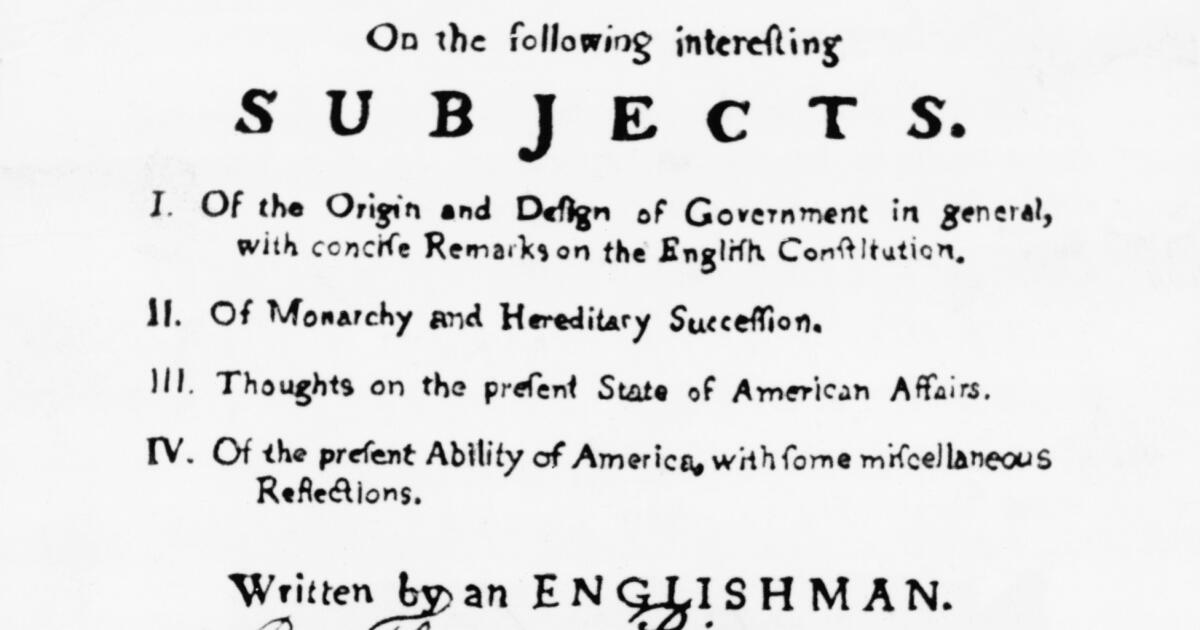
The 2024 presidential election painted a dismal picture — a country split red and blue, a near-even divide, reminding us how fractured we’ve become. Despite this polarization, nearly three-quarters of Americans agree on one thing: Our democracy is under threat.
In these respects, today’s America resembles the America of 1776, when divisions threatened the future of the democratic experiment. As patriots readied for battle and loyalists clung to the British crown, Thomas Paine published “Common Sense,” a fiercely persuasive pamphlet that united Colonists to fight against monarchy in the name of self-rule.
“It is not in numbers, but in unity, that our great strength lies,” Paine argued. To that end, he turned democratic ideals into a shared purpose. America, bound to the will of its people, challenged a world bound to the will of kings. And with “Common Sense,” Paine joined Americans together in the bold belief that “we have it in our power to begin the world over again.”
Soon, Paine’s pamphlet was everywhere — whispered by soldiers in Valley Forge tents, shouted in Philadelphia taverns, quoted in sermons. With half a million copies sold by the end of the American Revolution, “Common Sense” remains one of the best-selling works of all time relative to the U.S. population (2.5 million in 1776, not counting slaves and Native Americans).
If not for “Common Sense,” the United States might not exist as we know it. Now, nearly 250 years later, Paine’s pamphlet stands not just as a relic of history but as a blueprint for preserving democracy. From challenging authoritarian rule to limiting the sway of the wealthy to upholding the will of the majority, Paine’s words are more relevant now than ever.
And his message was clear: We must unite to confront the forces that threaten the republic — starting with the threat of absolute power.
Paine’s critique of unchecked authority was central to his argument for a government of, by and for the people. He saw King George III’s rule as the epitome of tyranny, and warned that “a thirst for absolute power is the natural disease of monarchy.” That warning resonates as Donald Trump returns to office with a well-documented record of testing and stretching the limits of power.
In July, as Trump’s efforts led the Supreme Court to expand presidential immunity, Justice Sonia Sotomayor’s dissent echoed Paine’s concerns. She wrote, “In every use of official power, the President is now a king above the law” — a deep departure from the assertion in “Common Sense” that “in America, the law is king … and there ought to be no other.”
But Paine’s concerns extended beyond authoritarian leaders. “Common Sense” also decried the outsized influence of the wealthy. With frequent condemnations of “aristocratical tyranny,” Paine scrutinized the rich as “slaves to fear” and alleged that “their minds are early poisoned by importance.” Paine believed American democracy could not survive if power was bought and sold by the wealthy elite. And, again, his warnings apply today.
Supreme Court rulings such as Citizens United, the decision that unleashed unlimited election spending by corporations and individuals, have turned Paine’s fears into our reality. The 2024 elections saw a staggering $16 billion in campaign expenditures — with money coming from small donors but also super PACs and at least 150 billionaire families. With Republicans and Democrats capitalizing on almost unchecked spending, both parties are complicit in a system in which influence can be bought by the highest bidder.
Paine’s rebuke of kings and aristocrats was grounded in a democratic bulwark: fair representation. Amid Colonial protests against unjust taxes, the cry “no taxation without representation” lit a rebellious spark. Then “Common Sense” set it ablaze, insisting that “there is no political matter which more deserves our attention” than “large and equal representation” — a demand unmet by America’s rulers across the sea.
Centuries later, as policies drift farther from majority views, Americans are confronting a new ocean. Not one measured in miles but in understanding, and just as vast. The fall of Roe vs. Wade disregarded the will of 63% of Americans who support access to abortion in “all or most cases,” according to the Pew Research Center. Pew reckons that 61% of Americans think it’s too easy to own a gun in this country, and 63% want to abolish the electoral college. But public will remains overshadowed by political tradition.
This gap between political realities and majority beliefs is fueled by tribalism and the pursuit of power, with party loyalty outpacing the needs and desires of constituents. As historian Craig Nelson told me, Paine would be “befuddled” by today’s red-versus-blue divide. For Paine, unity was not just an ideal but a survival strategy. Our modern polarization represents a surrender to the very forces Paine warned against.
To prevent American democracy from failing, we must learn from its beginning. And learning from “Common Sense” means upholding principles the Colonists died for: leaders accountable to the people, influence that cannot be bought and laws that reflect the will of the majority.
“Common Sense” was more than a rallying cry; it was Paine’s effort to forge an American identity rooted in a commitment to self-governance and trust in the power of the many — not the few. Paine’s greatest lesson is that our strength lies in our collective resolve to unite, just as democracy requires.
A democracy’s salvation lies within itself. To save the American experiment, we must remember how its potential first brought us together. Overcoming the darkness of our divides won’t be easy. But as “Common Sense” tells us, “The sun never shined on a cause of greater worth.”
A.T. McWilliams is a poet and writer based in Brooklyn.






